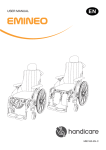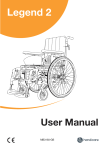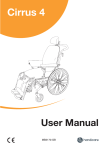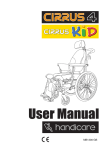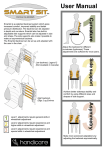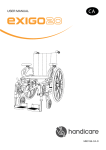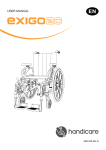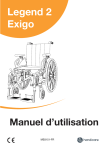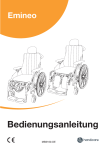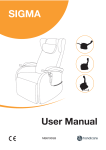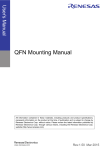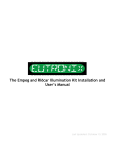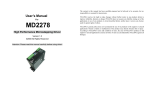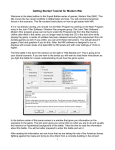Download Emineo Owner`s Manual
Transcript
MB3160-GB INTRODUCTION Congratulations on your choice of new wheelchair Quality and function are key aspects of all wheelchairs in the HandiCare series. HandiCare Produksjon AS Serviceboks 2626 Lillehammer NORWAY www.handicare.no Emineo is manufactured by Handicare Produksjon AS. Production takes place at Lillehammer in modern premises, using high-tech equipment. With the production at Lillehammer, we have excellent opportunities for influencing the design of the wheelchair models. We would be very pleased to receive feedback from you regarding your experiences with this wheelchair. This will help us to continue to improve the product. 2 For your own safety, and in order for you to get the best possible benefit from the features of your new wheelchair, we recommend that you read this user manual carefully before you start to use the wheelchair. Handicare Emineo in brief Emineo has been developed in line with the market. The result is a wheelchair with particularly good seating comfort through its unique tilt function and newly developed back solution. Emineo is an extremely light wheelchair, it rolls easily and has a narrow seat, which provides good capabilities for negotiating obstacles through narrow doors and in narrow rooms. By means of its extensive accessories programme, Emineo can easily be adapted to each user. Many different adjustments can be made and the adjusting procedures are intuitive and demand minimum use of tools and replacement of parts. Measuring scales on all adjustment points simplify the adjustments and ensure their accuracy. This user manual is for Handicare Emineo with serial number: . . . . . . . . . . . . . . . . . . . . . . . . . . . . . . . . . . . . The wheelchair was inspected and approved on:. . . . . . . . . . . . . . . . . . . . . . . . . . . . . . . . . . . . . . . . . . . . . . . . . by:. . . . . . . . . . . . . . . . . . . . . . . . . . . . . . . . . . . . . . . . . . . . . . . . . CONTENTS Introduction page 2 Contents page 3 Wheelchair parts page 4 Assembly page 5 Using the wheelchair page 6 Adjusting the wheelchair page 13 Hip belt page 27 Safety page 28 Safety in cars page 30 Maintenance page 33 Labelling page 36 Technical specifications page 37 Guarantee page 39 Accessories page 40 3 WHEELCHAIR PARTS In order to be able to properly understand this manual, it is important that you are aware of the commonest terms used to describe the various parts of the wheelchair. Examine the drawing below, and note the relevant parts on your wheelchair. The equipment on your wheelchair may vary slightly from that shown in Figure 1. The wheelchair is delivered with two types of equipment; “Basic” and “Onetool”. Where functions, controls and adjustments differ on Basic and One-tool equipment, this will be indicated in the text and figures in this user manual. Where Emineo is set up as an assistant-manoeuvred chair, it is equipped with different wheel dimensions and a brake lever for the assistant on the pushing handle. 4 Backrest and cover Pushing handle Assistant handle User handle Armrest Driving wheel Clothes protector Hand rim Seat Leg support Frame Wheel block Brake Footplate Anti-tip stabiliser Bearing housing for castor Castor wheel fork Figure 1 Castor wheel ASSEMBLY Assembly Figures 2 and 3 The standard wheelchair is delivered complete. All you need to do is: • Unfold the back, see page 10 • Fit the armrests, see page 6 • Fit the leg supports, see page 7 Figure 2 5 Figure 3 USING THE WHEELCHAIR Quick-release catch Figure 4 The wheelchair has a quick-release catch on the driving wheels. Press the button in the middle of the driving wheel in order to remove or attach the wheel. NB! Check that the wheel is properly secured by ensuring that the button pops out approximately 5 mm when the wheel bolt is completely in the casing. Figure 4 6 Height adjustable pushing handle Figure 5 The pushing handle is adjusted by loosening the locking handle (5A) whilst moving the pushing handle upwards or downwards to the desired height. Retighten the locking handle. For extra safety, the pushing handle is fitted with a snap lock in the uppermost position. To remove the pushing handle, pull it up to the uppermost position and press the snap lock (5B). B A Figure 5 Armrests, removing and fitting Figure 6 Remove the armrests by lifting them up. To fit them back on, place them in the armrest tubing. Figure 6 USING THE WHEELCHAIR Swing out/attach/remove the leg supports Figures 7 and 8 The procedure is the same for fixed and angle adjustable leg supports. The leg supports can be swung in/out or removed in order to make transport and getting in and out of the chair easier. The leg supports can be released by twisting the lever (7A) inwards or outwards whilst swinging the leg supports. After the leg support has been swung to the side, it can be lifted straight up and completely removed if desired. In order to attach it again, carry out these steps in reverse order, and the handle will lock automatically. A Figure 7 7 The complete leg support unit and fastenings can be removed, see page 25. Figure 8 NOTES Using the brakes Figure 9 Pull the brake lever towards you to engage the brake. The brake is only designed to hold the chair when it is stationary. Under no circumstances should it be used as a driving brake. Figure 9 8 To make sideways transfer easier, the brake lever can be folded down. This is done by pulling the brake lever upwards and then folding it down. Using the brakes on Emineo with assistant brake (assistant brake is standard on helper-guided chairs; also available as an accessory) Figure 10 • Squeeze the brake handles (18A) to brake • Push the release handle (10B) away from you to lock the brakes on when parking. Squeeze the release handle to release the brakes A B Figure 10 USING THE WHEELCHAIR Anti-tip stabiliser/tipping bar Figure 11 The anti-tip stabiliser is put into position by pulling it out and turning it in a downward direction simultaneously. The anti-tip stabiliser is adjusted as standard with a clearance to the base that makes it possible to mount doorsteps etc. The tipping bar is accessible when the anti-tip stabiliser is up or down. Figure 11 Tilting Figure 12 When you tilt the chair, the balance point is retained. As you tilt the chair backwards, the back opens 8°. You can use various methods for tilting the chair depending on your function level: • The assistant squeezes the tilt lever and the user leans forward/backward • The assistant squeezes the tilt lever and the user pulls himself forward/pushes himself backward using his hands A user-controlled tilt lever which the user can use without the help of an assistant, is available as an accessory. 9 Figure 12 Beware of pinching! The balance point on Emineo can be adjusted for optimal use in relation to the user’s function level and weight. See page 21. Do not put hands etc. between the side frame and leg support attachments when tilting the wheelchair. USING THE WHEELCHAIR Adjusting the back angle using the adjustment lever (accessory) Figure 13 Adjust the back angle separately using the lever (13A). • Squeeze the lever as you push the backrest forwards or backwards Fold the backrest up or down Figures 14 and 15 • Remove the armrests • Tilt the chair forwards. Pull out the bolt (14A) and turn it 90° to lock it in the open position, release the bolt and fold down the back A Figure 13 10 Carry out this procedure in reverse order to pull the back up. A Figure 14 Figure 15 USING THE WHEELCHAIR Moving in and out of the chair Figures 16, 17 and 18 • Activate the brakes • Swing out or remove the leg supports • Tilt the chair forwards • The user can now be moved in or out the wheelchair by means of manual lifting or a person lift, or frontal movement if the user has the ability to stand, see figures 16, 17 and 18 Figure 16 11 Figure 17 Figure 18 USING THE WHEELCHAIR Negotiating obstacles, stairs Figures 19 and 20 If the wheelchair is being lifted up/down stairs with the user sitting in it, the recommended lifting points should be used. These are marked on the product. The lifting points are the pushing handle and the leg supports. Figure 19 12 Do not lift the wheelchair by the armrests. Do not lift the wheelchair by angle adjustable leg supports. NB! Make sure that the pushing handle is locked before lifting. In order for assistants to have a better lifting position, they can alternatively lift from each side of the wheelchair. Figure 20 Negotiating obstacles, kerbs Figure 21 When negotiating kerbs etc., swing the anti-tip stabiliser up. Then place one foot on the tipping bar whilst steering with the pushing handle. Tilt the chair backwards where necessary to get clearance between the obstacle and leg supports. Steep terrain For frequent use in undulating terrain, we recommend that a separate brake is fitted for an assistant where relevant. Figure 21 ADJUSTING THE WHEELCHAIR Emineo has measuring scales that help you to adjust the chair accurately. The following adjustments can be carried out quicker and more accurately using the different measuring scales: • Seat height – back (One-tool) Pages 14, 16 and 17 The scale shows the seat height in relation to the dimensions of the driving wheels. • Centre of gravity (One-tool) Page 17 The measuring scale is numbered from 1 to 5, with 1 as the best anti-tipping position. • Seat height – front (One-tool) Pages 14, 15 and 18 Stepless scale from 1 to 9 to ensure equal adjustment on both castor wheels. • Angle of castor wheels (One-tool) Page 19 Stepless scale to ensure equal adjustment on both castor wheels. • Backrest height Page 20 The scale shows the backrest height from 50 cm to 60 cm. • Balance point Page 21 Stepless scale from 1 to 3. • Anti-tip stabiliser (One-tool) Page 23 The measuring scale is numbered from 1 to 5, in order to adjust the anti-tip stabiliser in relation to the driving wheel position. • Leg support length Page 24 Stepless scale from 1 to 9 to ensure equal adjustment on both leg supports. 13 ADJUSTING THE WHEELCHAIR Adjusting the seat height The seat height can easily be adjusted. The different ways of adjusting the seat height also affect the ability to negotiate obstacles and rolling properties of the wheelchair. NB! Do not adjust Emineo so that you have different seat heights at the front and back, as this can affect the balance point. Adjusting the seat height – back Figure 22 The seat height at the back can be 14 adjusted using the methods below. Moving the wheel block up or down Moving the wheel block up lowers the seat. Moving the wheel block down raises the seat. See page 16. Changing to bigger or smaller driving wheels A bigger driving wheel increases the seat height, whilst a smaller wheel decreases the height. The table on page 36 shows which seat heights can be achieved by changing to different sizes of driving wheel. Adjusting the seat height – front Figure 22 The seat height at the front can be adjusted using the methods below. The table on page 36 shows which seat heights can be achieved by using the different methods. Figure 22 ADJUSTING THE WHEELCHAIR • Move the bearing housing of the castor wheel up or down (One-tool) (see page 17) Moving the bearing housing up lowers the seat, and moving it down raises the seat. • Move the castor wheel to a higher or lower position in the castor wheel fork Moving the castor wheel to a higher position in the castor wheel fork (23A) lowers the seat, and moving the castor wheel to a lower position raises the seat. Castor wheel fork Bearing housing A Castor wheel Figure 23 15 • Changing to bigger or smaller castor wheels A smaller castor wheel reduces the seat height, whilst a bigger castor wheel increases the seat height. By changing the castor wheel, a smaller castor wheel will give a smaller turning radius, and thereby increase the ability to negotiate obstacles in narrow spaces, and will also give more room for the legs. A larger castor wheel will increase the turning radius but will also improve the ability to negotiate obstacles on uneven surfaces. • Changing to a longer or shorter castor wheel fork A shorter castor wheel fork reduces the seat height, gives a smaller turning radius, and thereby increases the ability to negotiate obstacles in narrow spaces, and will also give more room for the legs. A longer castor wheel fork increases the seat height, and allows several alternative castor wheels to be used. NB! Remember to adjust the angle of the castor wheel when you change the seat height. Remember also to adjust the brakes when adjusting the seat height at the back. ADJUSTING THE WHEELCHAIR 16 Adjusting the seat height – back (Onetool) Figures 24 and 25 On the wheelchair frame you will find a measuring scale (25A), which shows the seat height in relation to the size of the driving wheel. • Remove the driving wheel • Loosen the nut (25B) using a 27 mm wrench and unscrew until it stops • Pull the inner and outer wheel block slightly apart • Adjust the wheel block step-by-step up Figure 24 or down in accordance with the scale • Squeeze the inner and outer wheel block together A NB! • It is important to ensure that the pins in the wheel block go into the holes in the frame and that the casing lies horizontally in the track before tightening 20 35 38 37 1,5 44 4 3,5 46 4 Alternative driving wheel dimensions B 5,5 48 4 39 41 43 Figure 25 Seat heights that can be achieved by the different steps on the scale Find the dimension of your driving wheel at the top of the scale. The column under the wheel dimension shows where to place the wheel block in order to achieve the various seat heights. ADJUSTING THE WHEELCHAIR Adjusting the seat height – back (Basic) Figure 26 • Remove the driving wheel • Remove the wheel block by loosening the screws (26A). Use a 4 mm Allen key to unscrew the screws, whilst holding the nuts using a 10 mm wrench • Move the wheel block up for a lower seat height, or down for a higher seat height. Refer to the scale to find the right seat height • Replace and tighten the screws Adjusting the centre of gravity (Onetool) Figures 27 and 28 The driving wheel can be moved into 5 different positions in relation to the centre of gravity. This is shown on a scale (27A) on the wheel block. Position “1” represents the best anti-tipping position. • Loosen the nut (27B) using a 27 mm wrench, unscrew until it stops • Adjust the casing for the driving wheel forward or back (Figure 28) NB! it is important to ensure that the pins in the wheel block go into the holes in the frame and that the casing lies horizontally in the track before tightening the nut. A Figure 26 17 A 37 39 1,5 44 4 41 3,5 46 4 B 43 5,5 48 4 Figure 27 Remember to adjust the brakes and the anti-tip stabiliser after you have adjusted the seat height and centre of gravity. 35 38 If the backrest angle is configured up to a 30° angle, the rear position of the wheelbase should be used in order to avoid tipping of the chair. NB! When adjusting heights and the centre of gravity you should start by adjusting the driving wheels, followed by the height and angle of the castor wheels. 20 35 38 39,5 41,5 43,5 37 39 41 43 Figure 28 ADJUSTING THE WHEELCHAIR Adjusting the centre of gravity (Basic) Figure 29 Loosen the lock nut (29A) using a 27 mm wrench, whilst holding the casing (29B) using a 16 mm wrench. Turn the casing (29B) 90°. Move the wheel to the desired position. Turn the casing 90° back and retighten the lock nut securely. Remember to adjust the brakes and the anti-tip stabiliser after you have adjusted the seat height and centre of gravity. 18 A B Figure 29 If the backrest angle is configured up to a 30° angle, the rear holes of the wheelbase should be used in order to avoid tipping of the chair. Adjusting the seat height – front Figures 30, 31, 32 and 33 When adjusting the height of the chair, you should adjust the height of the castor wheels before adjusting the angle. Adjusting the height of the castor wheels (One-tool) Figure 31 The castor wheels have a scale from 1–9 to help achieve the same height on both castor wheels. • Loosen the screw (31A). Use a 5 mm Allen key • Adjust to the desired height, see the scale (31B) • Re-tighten the screw Do not adjust the height of the castor wheels beyond the scale. The figure should be visible in the hole on the castor wheel fastening. Figure 30 B Figure 31 A ADJUSTING THE WHEELCHAIR Adjusting the angle of the castor wheels/castor angle (One-tool) Figure 32 • Loosen the screw (32A) slightly. Use a 5 mm Allen key • Loosen the screw (32B) • Place the Allen key into the rotating disk (32C) and rotate to the desired angle. See the scale • Tighten the screw (32B), followed by the other screw (32A) When the castor wheel is at the correct angle, the bearing housing will be in a vertical position (90°) to the base. This is achieved by using a right angle to the bearing house/floor. The bearing housing level for achieving the correct angle can be supplied as an accessory (see page 38). Adjusting the angle of the castor wheels/castor angle (Basic) Figure 33 • Loosen the screws (33A) on the back of the bearing housing attachment using a 4 mm Allen key • Turn the hexagonal nuts (33B) so that the bearing housing is in a vertical position (90° to the base). To do this correctly, you should use a right angle to the bearing housing/base A C B Figure 32 19 A B Figure 33 ADJUSTING THE WHEELCHAIR 20 Adjusting the height of the backrest Figure 34 Before adjusting the height of the backrest, loosen the backrest cover. • Loosen the screw (34A) on each side of the back, using a 4 mm Allen key. (Do not unscrew the screw completely.) • You can adjust the back steplessly by pulling it up or pushing it down • Refer to the measuring scale in order to ensure an equal height at both sides • Make sure that the screw is in the Figure 34 highest or lowest position in the slot before re-tightening the screw and refitting the backrest cover Adjusting the neck support (accessory) Figure 35 Depth adjustment • Loosen the locking handles (35A), make the adjustment and tighten the locking handles Height adjustment • Unscrew the locking wheel (35B), raise or lower the neck support and tighten the locking wheel A A B Figure 35 Adjusting the angle of the backrest Figure 36 The backrest angle is adjusted from the underside of the wheelchair. • Use a 5 mm Allen key and a 13 mm wrench and loosen the screw and the nut (36A) • The standard backrest angle is 97°. By moving the screw to the back hole, the backrest angle will be 90° and then 97°, 105° and the front hole will give an angle of 110° • Re-tighten the screw 110° 105° 97° 90° A Figure 36 ADJUSTING THE WHEELCHAIR Adjusting the balance point for the seat tilt Figures 37 and 38 Adjustments to the balance point for the seat tilt should only be carried out by qualified personnel. Users are different sizes, weights and have different function levels. This affects how the seat tilt works, and how it can be balanced. A The function level, size and weight of some Figure 37 users will make it easier to tilt backwards than forwards. The balance point can be adjusted in accordance with this. 21 A Most users will prefer a balanced seat tilt, i.e. where the seat tilts just as easily forwards as backwards. 2 1 3 310 Pet Pend PCT/NO03/00 se manual Seteenhetens balanse, see manual Balance of the seat, Figure 38 Follow these steps to adjust the balance point of the seat tilt: • Remove the armrest and driving wheel. Use a 4 mm Allen key to unscrew the screw (37A) in order to remove the cover. Do the same with the cover on the inside, use a 3 mm Allen key. • Unscrew the screw (38A) using a 6 mm Allen key, hold onto the back using a 5 mm Allen key • Move the screw to the correct hole. The foremost holes make it easier to tilt backwards, whilst the rear holes make it easier to tilt forwards • Check that you always use the same holes on both sides of the chair. The holes are numbered and colour-coded, both on the internal and external sides • Re-tighten the screws and replace the covers ADJUSTING THE WHEELCHAIR Adjusting the curvature of the backrest Figure 39 The wheelchair has a padded backrest that can be adjusted to the curvature of the back in order to achieve a comfortable sitting position and good stability. The user can sit in the wheelchair when adjustments are being made to the curvature of the backrest. Loosen the back cover in order to access the Velcro tapes. These can be adjusted to change the backrest curvature and so achieve maximum comfort and support. Figure 39 22 If the wheelchair is set up with a low backrest, the top Velcro tape in the lower Velcro back will not be used. This is only used if you adjust the backrest upwards. A Adjusting the brakes Figures 40 and 41 The standard wheelchair is delivered with brakes that are fitted in the middle driving wheel position. To move the brake, loosen the screws (40A) on the inside of the frame at the front of the wheelchair using a 10 mm wrench. Move the entire brake in the track to the desired position. The correct distance between the brake block and the wheel (41A) is approx. 5 mm. Figure 40 The brakes that are supplied with the wheelchair will not normally need to be adjusted. A Figure 41 ADJUSTING THE WHEELCHAIR Adjusting the anti-tip stabiliser (One-tool) Figure 42 Adjust the anti-tip stabiliser when you have changed the centre of gravity of the A wheelchair. Loosen the screw (42A) using a 4 mm Allen key. Pull or push the anti-tip stabiliser to the correct position so that the measurement on the stabiliser’s measuring scale corresponds to the driving wheel position. Re-tighten the screw. There should be a maximum of 35 mm from the end of the anti-tip stabiliser to the base. To adjust this, loosen the screw (42B) using a 4 mm Figure 42 Allen key and pull/push the lower tubing on the anti-tip stabiliser. Re-tighten the screw. Adjusting the anti-tip stabiliser (Basic) Figure 43 Adjust the anti-tip stabiliser when you have changed the centre of gravity of the wheelchair. Loosen the wheel casing (43A) and the screws (43B). Push the anti-tip stabiliser forwards or backwards to the desired position and re-tighten the screws and wheel casing. B max. 35 mm A B There should be a maximum of 35 mm Figure 43 from the end of the anti-tip stabiliser to the base. To adjust this, loosen the screw (43C) using a 4 mm Allen key and a 10 mm wrench. Pull/push the lower tubing on the anti-tip stabiliser. Re-tighten the screw. C max. 35 mm 23 ADJUSTING THE WHEELCHAIR Adjusting the leg supports Figure 44 The leg supports have a linear scale (44A) on the outside, which helps to achieve the correct length. To adjust the length of the leg supports, loosen the fixing screw (44B) using a 5 mm Allen key. Then adjust the leg supports to the desired length and retighten the screw. 24 A quick-release catch for adjusting the length of the leg supports is available as an accessory (see page 37). Angle adjustable leg supports and leg supports with 70° and 90° hangers are available as accessories (see page 40). B A Figure 44 A Adjusting the angle of the legrests Figure 39 The angle of the legrests can be adjusted to 70˚, 80˚ or 90˚. • Remove the screw (39A) • Pull or push the legrest to the desired angle • Place the screw in the correct hole and tighten 70º Figure 45 Footplate – angle adjustment Figure 46 • Loosen the screw (46A) using a 5 mm Allen key. • Adjust to the desired angle and retighten the screw. A Figure 46 80º 90º ADJUSTING THE WHEELCHAIR Angle adjustable leg supports (accessory) Figures 47 and 46 Angle adjustment The leg supports can be adjusted separately. • Loosen the locking handle (47A) • Adjust the leg supports to the desired angle and tighten the locking handle Balf support adjustment • The calf support (47B) can be adjusted in depth and sideways A B Figure 47 25 Beware of pinching! ADJUSTING THE WHEELCHAIR Adjusting the leg support fitting Figure 48 The depth of the leg support fitting can be adjusted or the support can be removed. Loosen the screw (48A) using a 4 mm Allen key. Pull or push the leg support to the desired position. The leg support fitting must not be pulled out more than 8 cm. Re-tighten the screw. A Figure 48 Adjusting the seat depth Figure 49 26 To adjust the seat depth steplessly, loosen the four screws in the seat plate using a 4 mm Allen key. Push the seat plate forwards or backwards. Re-tighten the screws. When you have adjusted the seat depth, it may be necessary to adjust the leg support fitting, see above. Figure 49 A Adjusting the height of the armrests Figure 50 To adjust the height of the armrest, loosen the screw (50A) using a 10 mm wrench. Raise or lower the armrest to the desired position. Re-tighten the screw. Figure 50 HIP BELT Fitting the hip belt (accessory) Figures 51, 52 and 53 • Remove the seat cushion and loosen the backrest cover. For easier access when fitting the hip belt, loosen the four screws in the seat plate and pull the seat forward (use a 4 mm Allen key) • Fit the mounting brackets to the hip belt. Use a 5 mm Allen key and a 13 mm wrench, and screw in the screw (52A) and nut (52B). Repeat on the other side Figure 51 • Thread the seat belt through the brackets and under the seat plate 27 B • Push the seat plate back to its original position and re-tighten the screws in the seat plate A Figure 52 Figure 53 SAFETY • Do not stand, or exert great pressure, on the footplates • A wheelchair should be viewed as a replacement for walking. Users must therefore move among pedestrians, not on roads or streets with motorised traffic. Use reflectors when using the wheelchair outdoors, see page 28 • When transferring yourself out of the chair, take care to ensure that you are on as stable and even a surface as possible. To ensure that the chair does not move when you don’t want it to, check that the brake is engaged and locked • The maximum user weight for Emineo 4 is 140 kg • You should visually inspect the chair regularly to assure yourself that all screws, bolts and other fixing devices are securely fastened • When the chair is in use, always ensure that the anti-tip stabiliser is in the correct position 28 • If any modifications are made to the chair, such as moving the driving wheels or front castor wheels, changing the backrest height etc., this can affect the chair’s driving characteristics, balance and tipping point. Exercise particular care when you start to use the chair again • Avoid making modifications or alterations to the chair which may affect the safety which is built in to the chair’s construction • The use of qualified helpers is recommended when transferring into and out of the chair • Take care that clothes, baggage and other loose items do not get tangled up in the wheel spokes • Be aware of the possible danger of crushing injury: avoid putting your fingers between the clothing guard and the wheel, between the wheel and the brake, between the hand rim and the wheel, between the moving parts on the angle adjustable legrest and between the side frame and the leg support attachments when tilting • If while using the chair it is necessary to raise the front of the chair to negotiate an obstacle, never do this solely by pressing down on the pushing handles. Step on the tipping bar while using moderate pressure on the pushing handles • Sitting in the wheelchair for a long period of time increases the danger of pressure sores. If there is a high risk of pressure sores, we recommend the use of a special seat cushion to avoid this SAFETY Reflectors Figure 54 and 55 Use reflectors when using Emineo outdoors. See Figure 54 and 55 for reflector locations. Figure 54 29 Figure 55 SAFETY IN CARS Emineo as a passenger seat in a car Where possible, the wheelchair user should be moved to the passenger seat of the car and use the car’s seat belt. The wheelchair can be used as a passenger seat in a car and has been tested in accordance with ISO 7671/19. When the wheelchair is used as a passenger seat it should sit facing forward. The wheelchair must be attached to the fastening system it was tested for; Unwin WWR/ATF/K/R User fastening: QIR/3H/ATF/FA/WH The system is a 4-point fastening system. The system is a total system that fastens 30 both the wheelchair and user to the car. The system requires fastening rails to be mounted in the car. Emineo has marked off four points (Figure 54) that must be used when securing the wheelchair: • The rear tubing of the side frame, above the wheel block • The front tubing of the side frame, above the bearing housing When using Emineo as a passenger seat in a car, a neck support without a link for depth adjustment should be used. Handicare relinquishes itself of all responsibility in the event that Emineo is used as a passenger seat in a car using a different fastening system to the one mentioned above. Figure 56 SAFETY IN CARS Fastening the seat belt: • The stomach belt must be fastened at as steep an angle as possible; between 30° and 75° • The chest belt is fastened over the shoulder and chest • The seat belt is fastened as tightly to the body as possible and must not be twisted • Make sure the seat belt is not kept away from the body by the wheelchair parts, such as armrests and wheels. For correct positioning, see figure 57 • The chair must not be tilted backwards when used as a passenger seat in a car Figure 57 31 Make sure that the seat belt is not kept away from the body by the wheelchair parts, such as armrests and wheels. WARNING a) Where possible, the wheelchair should be in a forward facing direction and secured in accordance with the instructions from the manufacturer of the fastening system. b) This wheelchair is approved for use in cars and meets the requirements for forward facing transport and head on collisions. The wheelchair has not been tested for other positions in a vehicle. c) The wheelchair has been dynamically tested in a forward facing direction, with the user secured by both a stomach and chest belt (3-point seat belt) SAFETY IN CARS d) Both the stomach and chest belts should be used to reduce the risk of head and chest injuries in the event of colliding with parts in the car. e) In order to reduce the risk of injury to the user, tables that are fitted to the wheelchair, which are not designed for crash safety, must be: • Removed and secured separately in the vehicle, or • Secured to the wheelchair, but with energy-absorbing padding placed between the table and the user f) Where possible, other wheelchair accessories should be secured to the wheelchair or removed from the chair and secured in the vehicle during transport, so that they don’t become loose and 32 cause injury to the user in the event of a collision. g) Support and positioning equipment must not be regarded as safety equipment/seat belts if they are not labelled in accordance with the requirements of ISO 7176/19-20XX. h) The wheelchair should in inspected by a representative of the manufacturer before being used again after any kind of collision. i) No changes or replacements must be made to the anchorage points/car fastenings on the wheelchair, or to constructional elements or parts of the frame without consulting the manufacturer. j) When using electric wheelchairs in motor vehicles, gel-filled batteries should be used. MAINTENANCE The maintenance described in this section can be carried out by the user. Other maintenance work should be carried out by qualified personnel at your local supplier or at the technical aids centre. For information about repairs or service, ask the technical aids centre in your area. Washing the frame The frame should be regularly washed with mild soapy water. If the frame is very dirty, a scouring agent may be used. If necessary, the frame can be flushed using a high-pressure jet spray. Try to avoid spraying directly at the ball bearings. Dry the wheelchair thoroughly after washing or when it has been out in the rain. Grease all moving parts if you have used a scouring agent. Cleaning the seat and backrest covers The covers can be washed in a washing machine at 60 °C. See the washing instructions on the various textiles. Conditions which may damage the wheelchair The chair should not be used in temperatures below –35 °C or over 60°. No requirements are specified in connection with humidity and air pressure. No other requirements are specified for storage. Screws and nuts Screws and nuts can loosen over time. Therefore, remember to check and if necessary tighten them at regular intervals. A screw locking agent such as Blue Locktite (no. 243) may be used. If a locking nut has been removed, it loses some of its locking properties and should be replaced. Driving wheels The driving wheels are equipped with spokes. These should be adjusted if they begin to work loose. Ask a local bicycle dealer or your nearest technical aids centre. Quick-release hub for the wheels The quick-release hub for the driving wheels requires regular inspection. Check that the ball bearings are working satisfactorily. The release bolt and ball bearings should be cleaned and lubricated with oil regularly. 33 MAINTENANCE Recommended air pressures The chair can be supplied with solid or pneumatic wheels. Find the correct type and size of driving wheel or castor wheel, then read off the recommended maximum air pressure from the table. Note that a high air pressure makes the chair easier to roll, while a lower air pressure gives a softer ride. For optimal driving characteristics, the air pressure should be checked regularly. kPa Bar PSI Driving wheels, pneumatic tyres 350 3,5 50 Driving wheels, high pressure 630 6,3 90 Castor, 6” pneumatic tyres 250 2,5 35 Castor, 8” pneumatic tyres 250 2,5 36 Tools for service and maintenance of the wheelchair 34 Adjusting: Verktøy: Adjusting: Verktøy: Brakes 5 mm Allen key Backrest height 4 mm Allen key Balance point 3, 4, 5 and 6 mm Allen key Backrest angle 5 mm Allen key and 13 mm wrench Castervinkel 4 mm Allen key(Basic) 5 mm Allen key (Onetool) Centre of gravity 27 mm wrench (One-tool) 27 mm and 16 mm wrench (Basic) Seat depth 4 mm Allen key Leg support length 5 mm Allen key Seat height – back Footplates 5 mm Allen key 27 mm wrench (One-tool) 4 mm Allen key and 10 mm wrench (Basic) Anti-tip stabiliser 4 mm Allen key (One-tool) 4 mm Allen key and 10 mm wrench (Basic) Seat height – front 5 mm Allen key Armrest height 10 mm wrench Inspect after six months, and then every year • Check that the brake works correctly. Adjust if necessary • Check that the tyres are in good condition, with no damage to the sidewalls • See that the chair is clean and that all moving parts work correctly • Check for slack on the front castor wheel fork. Adjust if necessary. The axle should run freely about its axis, but there should not be any slack in an up/ down direction • Check and if necessary adjust all screwed joints MAINTENANCE Repairs Apart from minor repairs to the paint, changing the tyres or inner tubes, and adjusting the brakes, all repairs must be carried out by qualified personnel at your local supplier or at the technical aids centre. For information about repairs or service, ask the technical aids centre in your area. Removing the tyre • Take off the wheel, then deflate the tyre by holding down the small pin in the valve, or by unscrewing the valve out completely • See that the edge of the tyre is well down in the inward side of the rim (58A) • Bend the edge of the tyre over the edge of the rim. Use a special tyre lever (58B) if necessary. Ensure that the inner tube does not get squeezed between the lever and the edge of the rim B C A Figure 58 Fitting the tyre • Put the inner tube into the new tyre and apply an anti-friction agent (tyre fitting agent or soap) to the edge of the tyre (51C) • See that the edge of the tyre is well down inside the rim on one side. Bend the tyre over the edge. Ensure that the inner tube does not get squeezed • Inflate the tyre to the correct pressure and fit the wheel to the chair 35 LABELLING Product name Model Seat width Seat depth Max. user weight Serial number CE marking 36 700 001 Year and month of production Labelling for lifting points Angle of ascent Beware of pinching Anchorage points car 1 2 3 Balance point Pet Pend PCT/NO03/00310 Seteenhetens balanse, se manual Balance of the seat, see manual TECHNICAL SPECIFICATIONS Technical specifications and dimensions The wheelchair is delivered as standard in several different seat heights and seat widths. The height that best suits the user of the wheelchair depends on two factors: The height of the user and how the wheelchair will be operated. Ask your dealer or enquire at your nearest aids centre if you are uncertain as to whether you have the correct height and width. (Dimensions are given in centimetres unless otherwise specified. Measurements given can vary +/– 1 cm.) Seat width 39, 45 and 51 Seat depth 39 - 45 Seat height – front = standard The table shows front seat heights when using different kinds of fork and wheel sizes as well as seat heights when moving the position of the castor wheel inside the fork. The one-tool fork fastening also makes it possible to lift or lower the fork. Fork Castor wheel One-tool Basic 92 mm 4”/100 mm 36-42 36-38 92 mm 5”/125 mm 38-44 38 120 mm 5”/125 mm 38-46 38-42 120 mm 6”/150 mm 40-46 40-42 146 mm 5”/125 mm 38-48 38-44 146 mm 6”/150 mm 38-48 40-46 146 mm 8”/200 mm 44-48 46-48 Seat height – back Driving wheel Seat height – back 20” 36 - 44 22” 38 - 46 24” 40 - 48 Backrest height 50 - 60 Backrest angle 0˚- 15˚ / 0˚ - 31˚ Seat tilt -5˚ - 20˚ / -1˚ - 15˚ Armrest height 23 -33 37 TECHNICAL SPECIFICATIONS Driving handle height 90–110 Total height 115 Total width One-tool: Seat width +23 Basic: Seat width +20 Total length 100 Weight of chair 24 kg Transport weight 38 17 kg Transport width Seat width +18.5 Transport height 71 Max. user weight 140 kg The wheelchair and most of its fittings are produced in a special aluminium alloy. The backrest and seat covers are made of flame retardant material. The wheelchair can alternatively be delivered with solid/pneumatic tyres for the castor wheels and driving wheels. Areas of use Handicare Emineo is designed for both indoor and outdoor use. The chair has been developed for users with reduced muscular strength, movement, mobility and stability. Handling of waste Waste from packaging and parts of the wheelchair, as well as the wheelchair itself, can be treated as ordinary waste. The main constituent of the wheelchair is aluminium, which is suitable for remelting. The plastic and cardboard packaging can be recycled. GUARANTEE Guarantee: This guarantee applies to all new Handicare manual wheelchairs sold through authorised Handicare ASA dealers. A 2-year guarantee applies to the product, starting from the delivery date. Handicare ASA guarantees that the product will be free of faults with regard to both materials and workmanship, and will meet all the requirements specified in the sales brochure. Handicare ASA guarantees free repairs and maintenance, as well as replacement of any defective parts, provided that the damage was caused during normal use as described in the user manual. All claims, replacements of parts and service covered by the following limited guarantee must be presented to Handicare ASA in writing within 45 days of the incident in order to be entitled to compensation. Exclusions and limitations • Equipment that has been adjusted by someone other than Handicare ASA or a 39 representative of the technical aids centre is not covered by this guarantee • Tyres, inner tubes and upholstery are not covered by this guarantee • Damage to accessories is not covered by this guarantee • Equipment that is not treated with due care or is used in a way that is inconsistent with the guidelines in our user manual will not be covered by the guarantee Making a claim under the guarantee Equipment that proves not to work satisfactorily must be returned to the authorised Handicare ASA dealer from which it was bought. The dealer will undertake the necessary repairs and service. Handicare ASA will do its utmost to provide the dealer with the necessary parts to complete the repairs, but the guarantee covers neither carriage of equipment to or from the dealer nor a replacement for the buyer’s wheelchair while it is being repaired. If the buyer is unable to return the equipment to the authorised Handicare ASA dealer that sold it, the buyer should contact Handicare ASA’s head office in Norway (tel. +47 69 24 44 00) in order to obtain the name of an authorised dealer that can undertake the repair under the guarantee. The buyer should quote the model number, serial number, purchase date and a description of the equipment’s fault in all communication with the dealer. PB 5043 1503 Moss Norge www.handicare.com © HandiCare ASA 1998 - 2000 ACCESSORIES 1 3 2 6 5 4 8 7 40 9 10 12 16 21 11 15 13 17 22 18 23 19 20 GUARANTEE Driving wheel and driving wheel fastening • Driving wheel fastening with Impera wheel block (enables the camber angle to be adjusted) • Amputation block • Driving wheels in a variety of sizes and tyres – solid, high-pressure and pneumatic • Spider wheel 1 • Single hand operated wheel 5 • Friction hand rim • Friction cover • Spoke protectors 2 3 4 • Driving wheels 20”, 22” and 24” with brake for assistant • Transport wheels 12” and 16” with brake for assistant • Quick-release hub for poor hand function Castor wheel and castor wheel fastening • Castor wheels in a variety of sizes and tyres – solid and pneumatic • Castor wheel forks in different sizes • Small spirit level for castor angle 6 Brakes • Brake, pull to lock • Brake with long lever Leg supports • Angle adjustable leg supports 7 • Leg supports with 70° and 90° hangers • Short 80° hangers for leg supports • Footplate, depth adjustable 8 • Amputation support 10 11 • Quick-release lock for adjusting the 9 length of leg supports Back • Smartsit module 12 • Various types of neck supports • Side supports • User-operated tilt adjustment • Adjustment mechanism for separate adjustment of backrest angle Armrests and clothes protectors • Armrests with short pads • Hemiplegia armrests 23 Miscellaneous accessories • Gas-filled strut for tilt • Cushion to reduce seat width 13 • Pump, electric 20 • Crutch holder • Table 22 • Seat cushion 16 • Seat cushion Smartsit Basic 17 • Seat cushion Smartsit Comfort 18 • Hip belt 19 • Rucksack • Satchel • Anti-tip stabiliser swing forward with leg 21 Fitting instructions are supplied with the accessories. Contact your nearest Handicare branch or aids centre for accessories and spare parts. 41 NOTES 42 NOTES 43 Warning: The content of this user manual is only intended as information. This information may be changed without warning and must therefore not be interpreted as an obligation on the part of Handicare Produksjon AS. Handicare Produksjon AS takes no responsibility, legal or financial, for any errors or inaccuracies which may be found in this user manual. All products described in this user manual are registered trademarks and cannot be utilised in other contexts without the consent of Handicare Produksjon AS. 07-Utgitt mai 2007 HandiCare Produksjon AS Manufactured by: Handicare Produksjon AS www.handicare.no













































